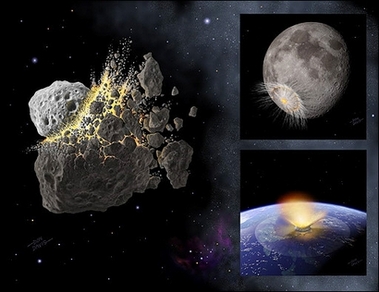Astronomers at
UCLA,
Tennessee State University and the
California Institute of Technology have reported that
two terrestrial planets orbiting a mature sun-like star some 300 light-years from Earth recently suffered a violent collision."Astronomer are now writing a report on this event in December issue of the
Astrophysical Journal. ACCORDING TO ASTRONOMERS:
ACCORDING TO ASTRONOMERS:According to
Benjamin Zuckerman, (Professor of physics and astronomy in UCLA), this collision was just like if
Earth and Venus collided with each other,". It is the first time that Astronomers have seen such collision.
Co-author of the report and astronomer in Tennessee State University, Dr. Gregory Henry says,
"If any life was present on either planet, the massive collision would have wiped out everything in a matter of minutes - the ultimate extinction event." After that collision a massive disk of infrared-emitting dust has encircled the star.
HOW THE REASEARCH CAME OUT:Zuckerman, Henry and Michael Muno, were studying a star
BD+20307 located in the constellation Aries and surrounded by a
1 million times more dust than is orbiting our sun. These astronomers gathered X-ray data using the orbiting Chandra X-ray Observatory and brightness data from one of TSU's automated telescopes in southern Arizona, hoping to measure the age of the star.
They thought that BD+20 307 was relatively young, a few hundred million years old , with the massive dust ring which signals the final stages in the formation of the star's planetary system. But
Alycia Weinberger of Carnegie Institution of Washington announced that BD+20 307 is actually a close binary star means
two stars orbiting around their common center of mass.The new spectroscopic data collected after this announcement confirmed that BD+20 307 is composed of two stars, both very similar in mass, temperature and size to our own sun and they orbit about their common center of mass every 3.42 days. Further research also shown that these stars are much more older than estimated before. Instead of few hundred million years these stars are several billion years old.
The planetary collision in BD+20 307 was not observed directly but rather was inferred from the extraordinary quantity of dust particles that orbit the binary pair at about the same distance as Earth and Venus are from our sun. Henry said. "If this dust does indeed point to the presence of terrestrial planets, then this represents the first known example of planets of any mass in orbit around a close binary star."
BD+20 307: THE EARLIER THOUGHTS Zuckerman and colleagues first reported in the journal Nature in July 2005 that BD+20 307, then still thought to be a single star, was surrounded by more warm orbiting dust than any other sun-like star known to astronomers. The dust is orbiting the binary system very closely, where Earth-like planets are most likely to be and where dust typically cannot survive long. Small dust particles get pushed away by stellar radiation, while larger pieces get reduced to dust in collisions within the disk and are then whisked away.
Thus, the dust-forming collision near BD+20 307 must have taken place rather recently, probably within the past few hundred thousand years and perhaps much more recently, the astronomers said.
NOW THE TWO IMPORTANT QUESTION IS:After this all research the two most important questions before astronomers are:
1.) How do planetary orbits become destabilized in such an old, mature system?2) Could such a collision happen in our own solar system?According to some esteemed astronomers, there is small probability for collisions of Mercury with Earth or Venus sometime in the next billion years or more.

According to
Zuckerman, major collisions have occurred in our solar system's in past. It is believed by many astronomers that our moon was formed from the collision of two planetary embryos - the young Earth and a body about the size of Mars - a crash which created tremendous debris, some of which condensed to form the moon and some of which went into orbit around the young sun. The collision of an asteroid with Earth 65 million years ago, which ultimately resulted in the demise of dinosaurs is also an example of such collision.
FUNDINGThis research is federally funded by the
National Science Foundation and
NASA and also by
Tennessee State University and the state of Tennessee, through its Centers of Excellence program


